New blog address
The Climate and Environment at Imperial blog has moved. Visit our new blog.
The Climate and Environment at Imperial blog has moved. Visit our new blog.
By Dr Flora Whitmarsh, Grantham Institute
The recently published 2015 Global Peace Index , produced by the Institute for Economics and Peace, said that although OECD countries became more peaceful in 2014, there has been substantial increase in annual war-related deaths since 2010, and there are now more refugees than at any time since the Second World War. It is currently difficult to give a definitive answer as to whether climate change could exacerbate these problems.
, produced by the Institute for Economics and Peace, said that although OECD countries became more peaceful in 2014, there has been substantial increase in annual war-related deaths since 2010, and there are now more refugees than at any time since the Second World War. It is currently difficult to give a definitive answer as to whether climate change could exacerbate these problems.
Climate change is likely to exacerbate a range of environmental problems including heat waves, water shortages, and extreme weather and flooding, but whether or not this will lead to increased rates of armed conflict is still the subject of research. According to the IPCC’s Fifth Assessment Report, some of the factors that increase the risk of conflict – recession, low per capita incomes, and inconsistent state institutions – are sensitive to climate change, but this does not necessarily mean that climate change will lead directly to higher rates of war and unrest.
Environmental factors more generally do play a key role in triggering unrest. An example of this is the role of water shortages in causing the recent Syrian war: farmers who had lost their livelihoods were forced to migrate to the cities, where they struggled to integrate and find work. The resulting uprisings then played a part in triggering war. Although conflict is sometimes triggered by a single environmental problem which acts as a tipping point, environmental factors usually combine with other factors to exacerbate war and unrest.
In his book, Global Crisis: War, Climate Change and Catastrophe in the Seventeenth Century, Geoffrey Parker argues that the unusually cool conditions (a 3 degree lower global temperature) during the seventeenth century “Little Ice Age” played a key role in sparking the steep rise in conflict sometimes referred to as the General Crisis. Surviving records from Europe and Asia paint a picture of extremely widespread famine and instability. In Europe for example, almost no country avoided war during the 1640s, and between 1618 and 1678, “Poland was at peace for only 27 years, the Dutch Republic for only 14, France for only 11, and Spain for only 3.”
Parker argues that the seventeenth century environmental deterioration caused by a decrease in solar energy reaching Earth and an increase in volcanic and El Niño activity has had “few parallels” and that “the frequency of wars and state breakdown created unprecedented political, social and economic instability.” Although the modern world is more integrated than the world of the seventeenth century, the argument linking periods of environmental instability with increased rates of conflict is potentially applicable to human induced climate change.
Dr Mark Workman of Imperial College London said, “The hypothesis for the causes of the General Crisis is very compelling”, but cautioned that “in the modern globalised and increasingly interconnected world the causative mechanisms are very controversial and I think the jury’s still out as to the degree to which environmental impacts are important as a cause in contemporary conflict.”

But environmental problems don’t always lead to conflict. “One thing that’s been missing from the current narrative is that there are opportunities for confidence building measures and co-operation,” says Dr Workman. Disputes over trans-boundary rivers often lead to increased cooperation because neighbouring regions or countries have an incentive to work together to make sure water is distributed fairly. “As history has demonstrated, through confidence building measures and sensible mechanisms of water allocation or resource allocation you can actually find ways to make one plus one equal two”, continued Dr Workman.
More research is needed to explain the precise mechanisms by which environmental factors spark conflict, and how this relates to climate change. Key to this is acquiring more and better data. Relevant data can be hard to obtain at present; for example the global FAO food price index is of little use in evaluating stressors in Tunisia and Syria, both of which have very localised food markets. In addition, research has tended to centre on the Middle East and North Africa Region, so there is a need for more widely applicable research.
A high proportion of global conflicts currently occur within, rather than between, countries, which would also apply to conflicts involving environmental problems, so future work is likely to focus especially on this area. Dr Workman says, “Environmental enhanced conflict will be more a subnational manifestation, because there is world trade at a national level, whereas within fragile conflict-affected states, which are home to nearly 20% of the world’s population, there are limited trade and transport mechanisms to address the resource arbitrage.”
With its wealth of technical expertise, the Grantham Institute at Imperial College London is well placed to bring together the fragmented work and carry out new research in this area. There will be three key steps involved in taking this forward. First, knowledge gaps need to be identified. Second, theories about how conflict interacts with environmental factors need to be verified using case studies. The third and most challenging step is developing ways of predicting how environmental factors may exacerbate or cause conflict in the future.
A publication released last week has highlighted an agenda for research.
by Dr Kris Murray, Grantham Lecturer in Global Change Ecology
 Today the Lancet Commission on Health and Climate announced the release of their new report “2015 Lancet Commission on Health and Climate Change: Policy Responses to Protect Public Health”.
Today the Lancet Commission on Health and Climate announced the release of their new report “2015 Lancet Commission on Health and Climate Change: Policy Responses to Protect Public Health”.
Following a first report released in 2009, which concluded that “Climate change is the biggest global health threat of the 21st century”, today’s report has a proactive, positive take-home: “tackling climate change could be the greatest global health opportunity of the 21st century.”
Strategically released following the 68th World Health Assembly held last month and in the lead up to the UNFCCC’s COP21, to be held in Paris later this year, the report is the culmination of a second international (predominantly Chinese-European) working group assembled to assess the health impacts of climate change and to identify and accelerate effective mitigation and adaptation policies over the next 5 years.
The report provides 9 recommendations and delivers 1 promise:
Accompanying the launch of the report, the Lancet Commission on Health and Climate are holding a number of events around the world (including London, New York and Canberra), which will include speakers, panel discussions and an opportunity for Q&A from participants. The Health and Environment Alliance will also host a virtual launch event.
While the recommendations are not exactly breaking radical new ground, they do represent a welcome synthesis of the front-line evidence on the health impacts of climate change with a clear focus on solutions (the details of which make up the bulk of the report).
Perhaps more critically, they also crank up the volume of the voice of the health community at a critical time in the climate change arena – a voice that has a formidable track record of achievement in confronting other highly complex, trans-national, politically charged threats to health.
For further comment on the report, see the Lancet website.
Building resilience to extreme weather needs a systems approach, including institutional ‘software’ as well as technical, financial, and physical infrastructure – or ‘hardware’. Designing, financing, achieving and evaluating success in the intangible aspects of resilience is challenging. Illustrating the systems approach to this challenge, the International Institute for Environment and Development (IIED) has been supporting the government of Kenya to invest in social software as a means to manage variable resource availability in the northern drylands.
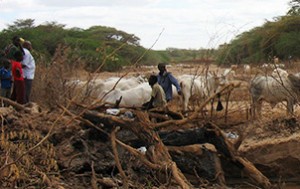 Between 1980 and 2012, it is estimated that the annual damage from extreme-weather related events rose from $20b to 150b, totalling close to US$2 trillion, of which only ¼ was insured. Examples include floods in Bangladesh and Thailand, typhoons in the Caribbean and droughts in the West African Sahel and Horn of Africa. Poor people and nations have been particularly vulnerable to the impacts of these events; people living in countries with a low Human Development Index make up only 11% of those exposed to hazards but account for 53% of disaster mortality.
Between 1980 and 2012, it is estimated that the annual damage from extreme-weather related events rose from $20b to 150b, totalling close to US$2 trillion, of which only ¼ was insured. Examples include floods in Bangladesh and Thailand, typhoons in the Caribbean and droughts in the West African Sahel and Horn of Africa. Poor people and nations have been particularly vulnerable to the impacts of these events; people living in countries with a low Human Development Index make up only 11% of those exposed to hazards but account for 53% of disaster mortality.
Even if we manage to cut greenhouse gas emissions rapidly and effectively from today, we must anticipate 20-30 years of growing impacts from climate change due to lags in the global atmospheric system. Drought, floods, and heat waves are all likely to increase in both frequency and intensity. The impact of tropical storms and associated sea surges will be amplified by sea-level rise. Disaster preparedness is key to help minimise loss of life and property, as well as speeding recovery post-disaster. ‘Resilience’ has become a widely used term to describe the quality of human-environment systems and their response to disaster. More than merely coping with individual extreme weather events, however, it means “looking at the capacity of individuals, communities and systems to not only survive, but also adapt and grow in the face of stress and shocks.”
Building resilience to extreme weather needs a systems approach, which involves investing in a combination of technical, economic/financial, and institutional dimensions. When faced with a threat such as drought or flooding, the first instinct is to invest in hardware – such as dams to capture and store water for dry periods, or sea-walls to protect from floodwater. And such tangible infrastructure is clearly very important. But alongside such investment in the physical hardware of protection, there are a range of vital intangible investments needed in the software of institutions for managing variable resources, and sharing risk. Institutions may be invisible, but their strength can make a big difference in how societies cope with disaster. Building resilience also requires shared action and responsibility at local, national and international levels, by the public and private sectors, local communities and non-governmental organisations. We will use the case of northern Kenya to illustrate this systems approach, and the role that different actors need to play.

Investing in local institutions in Northern Kenya
With funding from the UK’s Department for International Development (DFID), IIED has been supporting the government of Kenya to build resilience in the northern drylands. Over the last 15-20 years, this large drought prone region has suffered more intense and frequent drought events. Climate predictions for Kenya anticipate increasing frequency and severity of droughts and floods.7 The extended drought of 2008-11 caused livestock losses estimated at around 40-60% in some parts of Isiolo County. With an expectation of five years or less between drought events, there is not enough time for herds to recover from losses of such magnitude. This has a devastating impact on people’s livelihoods, since 80% of the population are dependent on livestock.
The new Constitution of Kenya affirms a strong decentralised approach, better to address the priorities of local people through putting decision-making into their hands. Equally, the government has recognised the long-standing marginalisation of pastoral livestock keepers in this large northern region, and the need for a revised approach which understands the rationale for herd mobility. Keeping animals mobile makes the best use of seasonally variable grazing and water resources, as well as helping people manage with unexpected rainfall and pasture change. This means having collective management of large areas of grazing, and the ability of different groups to move herds between areas. Key elements to support this mobility include recognised ownership and management rights, co-ordinated by community groups, and flexible access arrangements. Working with traditional institutions to invest in water points is frequently the key-stone to better management of surrounding grazing.
Amongst the Boran people of Northern Kenya, the Dedha is a customary neighbourhood institution for management of natural resources. Local Dedha councils identify which grazing areas need to be set aside for drought reserves – in these areas no one should graze their animals except during drought periods. The Dedha decide when these rules should apply and ensure such decisions are respected by herders. Young men are trained to patrol pasture and water areas to make sure people adhere to the rules.
Since 2011, IIED has been working to help establish the Isiolo County Adaptation Fund, as a pilot to be managed at the county level, ensuring funds are prioritised by vulnerable communities to build their own resilience. The fund has supported a range of investments, which include rehabilitating sand dams, digging new boreholes, fencing of critical areas and setting up a radio station.16 In particular, the fund has supported activities to strengthen the Dedha. By designating and directing herds to areas of seasonal grazing during the wet season, these customary bodies conserve high value grazing and water for use over the dry season.
Evaluating the benefits of investing in institutions
By the middle of 2014, drought conditions had worsened across the north of Kenya and the National Drought Management Authority (NDMA) was reporting a rapid decline in climatic, vegetation and socio-economic indicators across Marsabit, Wajir and Garissa counties. But in Isiolo alone, animal health, child nutrition, and livelihoods seemed to have been less affected by the worsening drought.
It can be difficult to estimate the impacts of such efforts to strengthen the Dedha vis-à-vis what might have happened had these interventions not been undertaken. Working with the Dedha in an effort to conduct such an analysis, IIED carried out a participatory assessment to estimate the benefits gained from better management of dry season grazing and drought preparedness, in terms of livestock survival rates, milk production, and reduced disease incidence.
Shortly after this assessment with the Dedha was carried out, rains arrived in most parts of the county and fortunately a full-blown drought emergency did not develop.Nevertheless, the Dedha members argued that by October 2014, livestock mortality rates would have been as high as in previous drought years, if they had not set aside drought reserve areas.
Although milk production usually stops in the long dry season and animals get sick more often, in 2014 these impacts did not occur. An estimate was made of the value of milk produced at this time and expenditures on medicines avoided, which were added to the estimated annual income to the Dedha from livestock sales. This partial identification of benefits from adaptation could then be compared with the costs of investment, both through the Isiolo County Adaptation Fund, and the contributions made by local people.
Because the NDMA datasets showed that the vegetation conditions during 2014 were not in fact as bad as they had been during the 2011 drought, this introduced doubt concerning the levels of avoided livestock mortality estimated by the Dedha. Since it was not possible to verify what level of livestock mortality would have occurred during 2014 without theDedha’s interventions, the value of all avoided mortalities that the Dedha members had identified was removed from the calculation of benefits achieved during 2014. Even on this basis, Dedha members had still secured a remarkable return on their investment of at least 24:1. But had the rains not arrived when they did, and a serious drought occurred, the value of the avoided mortalities would be included in the return on the investment. This would then have yielded returns almost as high as 90:1.
In addition to the local herds, livestock and people from neighbouring counties migrated into Isiolo. This helped them reduce their livestock losses and maintain milk production, and household nutrition – key benefits of particular value to women. The value of these additional benefits from the Dedha’s natural resource stewardship to the communities that they hosted from areas outside the county was even greater than the value of benefits received by Dedha members themselves. The market value of dry season milk produced by the animals belonging to the displaced pastoralists was 342 times the Isiolo CAF investment in strengthening the Dedha and 50 times the cost of the entire DFID program (£455,687, including all of its start-up, overhead costs, and all funds spent on all types adaptation projects, not just the institutional strengthening of the Dedha).
A broad range of other beneficial effects on the economy and society were noted but could not easily be valued. These included the reduced need to migrate long distances for water and pasture, resulting in reduced security risks and increased time spent at home with family and time spent taking care of local business. Strengthened local institutions enhanced the voice of local leaders and created employment for young men who played a key role in resource surveillance, as well as reducing dependence on food handouts and social assistance. If these benefits could also be quantified, they would demonstrate the very significant return on investment in natural resource management to both local families, and the public finances of Isiolo and the surrounding counties.
Building resilience for the future
In the coming years societies around the globe will need to find ways to build greater resilience to extreme climate events in this warming world. Investment in physical infrastructure, the hardware of disaster resilience, needs to be matched by strengthening of intangible but powerful institutions that help people manage risks and achieve collective agreement on how resources are best used. The example of the Dedha in northern Kenya shows the considerable returns gained from investing in social software, by re-establishing customary management systems, as a means to manage variable resource availability. While much of the work and investment is made locally, its ability to operate effectively relies on the national level framework to decentralise power and decision-making to county level. Equally, the funds from international donor agencies, such as the UK’s DFID, have helped make this pilot possible, from which it is hoped that many other such initiatives can learn.
Camilla Toulmin is Director of the International Institute for Environment and Development (IIED). Daoud Tari is a Visiting Fellow at IIED and leads the Resource Advocacy Programme (RAP), a community trust based in Isiolo County, Kenya. Caroline King-Okumu is a Senior Researcher working for IIED’s Climate Change Group. The work described in this article has been undertaken by IIED in collaboration with many colleagues from Kenya, especially Ibrahim Jarso, Hildah Kathare, Lordman Lekalkuli, Luigi Luminari, Nelson Mutanda, Nour Godana, Mumina Bonaya, Cynthia Awor, Jane Kiiru, Victor Orindi, and IIED colleagues Morgan Williams, and Kate Green.
This blog first appeared on ANGLE. View original for full references.
A Global Village, Imperial College London’s science and policy journal, is relaunching as ANGLE, an online only journal focusing on the intersection of science, policy and politics in an evolving and complex world. Visit ANGLE
By Clea Kolster, PhD student, Science and Solutions for a Changing Planet

The term ‘sustainable development’ was first coined in 1987 in the UN’s World Commission on Environment and Development report, Our Common Future. Almost 30 years later, the concept of sustainable development is more relevant than ever.
The definition given in the report is, to this date, the most widely accepted modern definition of the term: ‘Sustainable development is development that meets the needs of the present without compromising the ability of future generations to meet their own needs.’ Climate and society, energy, water, ecosystem health and monitoring, global health, poverty, urbanization, natural disasters, food, ecology and nutrition – these are some of the main problems that need to be tackled when discussing the possibility of sustainable development. They are all complex problems that require an interdisciplinary and analytical approach. Earlier this year, I joined a group of people doing just that.
On Friday April 3rd 2015, I entered the land of Ivy League elites of Columbia University to take part in the 5th Annual Interdisciplinary PhD Workshop on Sustainable Development. Having been on a year abroad at Columbia University during my undergraduate degree, I knew the spot pretty well and was thrilled about getting the chance to come back as a matured and informed PhD student ready and eager to present my work.
Arriving at the workshop, I struck up a conversation with some of the students around me. I quickly understood that a number of us had made the cross-Atlantic trip, with participants from Denmark, Italy, Sweden, France and even Australia. Students also came from Canada and Mexico, with a large majority attending world-renowned US universities, including Harvard, MIT, Yale, Princeton, UC Berkeley and of course Columbia.
The highlight of the first day was a keynote speech by American economist Jeffrey Sachs, head of the Earth Institute at Columbia University., Sachs has an incredible track record: he is a Quetelet professor (honorary distinction given to Columbia University professors, awarded to only four professors since 1963) of Sustainable Development, special advisor to Ban Ki-Moon, youngest economics professor at Harvard University (age 28), author of three New York Times bestsellers – and the list goes on.
One of the things that engrossed me most was his emphasis on planetary boundaries and the current ideological conflict between growth (mostly economic) and environmental sustainability. Sachs definitely got the whole room thinking about whether or not sustainable development is actually feasible and, for those like myself who desperately want that answer to be positive, what one can do to bring us closer to that goal: a world with sustainable economic, social and environmental objectives.
The rest of the afternoon featured sessions on a variety of topics from natural disasters – including the Venetian example of floods – to urban planning in China and development in India. After a long afternoon of presentations, I got the chance to network and socialize with the students. I met some very interesting individuals, most of whom, contrary to myself, feel as though they are economists before anything else, in spite of an earlier education in engineering.
On the second day, I was due to give my presentation as part of the Energy. In a small room filled with 10-15 other PhD students, all of whom were senior to me, and a few professors, I sat nervously waiting for my turn, beginning to realize that my presentation was clearly going to be one of the most “engineeringy” and technical of all.
I finally gave my 20 minute talk on the “Techno-Economic Analysis of the Link between Above Ground CO2 Capture, Transport, Usage for Enhanced Oil Recovery (EOR) and Storage”. I was happy to take some interesting questions at the end of it (which I hoped meant that the audience was actually interested by my topic) and later on at the coffee reception engaged in some stimulating discussions with some of my peers. It was clear that in spite of our dissimilar approaches, we had all contributed to responding to the question of sustainable development and its feasibility.
Did you know that 1.4 billion people currently live in a state of extreme poverty at below $1.25/day? In fact, it will take a 4 to 5 time increase in total global output by 2050 to get poor countries to meet the $40,000 per capita income of rich countries today. With figures like these, it isn’t surprising that large groups of individuals around the world dedicate their time to assessing and analyzing the best ways of achieving sustainable development encompassing economic, social and environmental goals.
In my view, sustainable development is feasible, we can tackle climate change, we can reduce our exploitation of natural capital while promoting economic growth, we can bridge the gap between poor and rich countries; the problem is – as Jeff Sachs pointed out – a lack of trust. A lack of trust leads to social and political instability and these will always impede sustainable development around the world.
References
World Commission on Environment and Development – Bruntland Commission. 1987. Our Common Future. s.l. : Oxford University Press, 1987.
Find out more about Clea’s research
by Dr Erik van Sebille, Grantham Lecturer in Oceanography and Climate Change
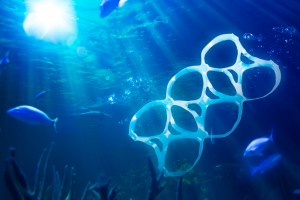 Our oceans are filthy with plastic. Most attention so far has focused on the bottles, carrier bags and other junk floating in the middle of our oceans. Some say that we ought to go out there and clean the stuff up. But a series of recent high-profile studies suggest that this stuff is only 1% of all the plastic in our oceans. The question on this World Oceans Day 2015 is, where is the other 99%?
Our oceans are filthy with plastic. Most attention so far has focused on the bottles, carrier bags and other junk floating in the middle of our oceans. Some say that we ought to go out there and clean the stuff up. But a series of recent high-profile studies suggest that this stuff is only 1% of all the plastic in our oceans. The question on this World Oceans Day 2015 is, where is the other 99%?
It’s hard to imagine a life without plastics, and this awesome material has greatly advanced our standard of living. However, some of this plastic ends up as waste in our ocean, where it clearly doesn’t belong.
A recent inventory in the journal Science estimated that around 10 million metric tons of plastic entered the ocean in 2010 alone.
However, two independent surveys have found that all the plastic bobbing around on the surface of the ocean weighs less than 100,000 metric tons.
So the amount of plastic at the ocean surface is two orders of magnitude lower than the amount of plastic that entered the ocean in 2010. Even with the large uncertainty margins on all these estimates, the conclusion must be that most of the plastic in the ocean has gone AWOL.
There are not too many places where the remaining plastic can be. It’s either on the seafloor, in the stomachs of animals, or on shorelines. The problem is that we don’t even have ballpark figures of how much plastic is in each of these places.
We know that there is probably a lot of plastic on the seafloor, where it impacts small critters crawling around. Not all plastic is buoyant enough to float, so some of the plastic will sink very quickly after it enters the ocean. Other plastic may float for a while but over time become so heavy with algal growth that it starts sinking. Unfortunately, we have only a few localised samples of plastic on the seafloor, and no idea how to scale these up to the entire ocean.
The second reservoir, inside animals, is probably the most worrisome of all. Most plastic that enters the ocean gets fragmented by wave action and sunlight, and after a few months to years ends up as tiny microplastic pellets. These tiny pellets might be quite easily ingested by large plankton and small fish. However, once again we have no clue how much plastic we are talking about globally.
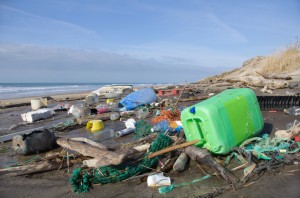 The shorelines, finally, would be my personal bet on where most of the plastic ends up. My own research at the Grantham Institute has shown that currents move plastic around in complex ways and it can linger near the shore for months. Much of the plastic that enters the ocean could just wash up with the next big storm.
The shorelines, finally, would be my personal bet on where most of the plastic ends up. My own research at the Grantham Institute has shown that currents move plastic around in complex ways and it can linger near the shore for months. Much of the plastic that enters the ocean could just wash up with the next big storm.
Shorelines come in many forms, from beaches to rocky outcrops to mangroves, and most of them are very remote and littered with plastic. Even the seemingly clean ones here in the UK might actually receive a lot of plastic, but volunteers and local councils clean them up at such a rate that we don’t realise just how filthy they are. There are great apps to report plastic on beaches, and widespread use of them would really help science.
We need to know where our plastic ends up if we want to understand its impacts on marine animals and ecosystems. And crucially, we need to stop polluting and remove plastic waste as close to the source as possible. Engineers are starting to think about how to do this with contraptions such as the Baltimore Waterwheel, but more bright ideas are needed.
If the case of our missing trash shows us anything, it’s that plans to clean up the floating plastic in the middle of the ocean do not really address the biggest problem. It would be far more effective to make sure no plastic ever enters the ocean in the first place. A stitch in time saves nine.
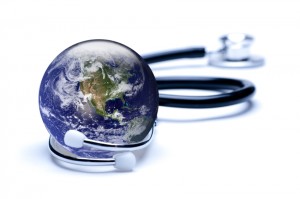
Dr Kris Murray, Grantham Lecturer in Global Change Ecology
Our planet is ill. Ongoing loss and endangerment of species, degradation of marine and terrestrial ecosystems and their services, and manmade changes to the global climate are dramatic symptoms of a major decline in the planet’s environmental health.
In glaring contrast, human health has improved, in some cases radically. Decreases in malnutrition, mortality due to infectious diseases and infant mortality rates, accompanied by substantial increases in life expectancy, can be observed in every major region of the world.
So why is health winning a war, while the environment is losing one?
At a fundamental level, there is a huge difference in investment. Human health is a global priority and survival, healthiness and well-being are personal objectives for almost everyone. Preservation of the environment simply isn’t. Spending on global health, for example, is at least an order of magnitude greater than for environmental conservation.
But surely it’s not that simple. Ecosystem services and human health and well-being are supposed to be deeply interconnected, right? So how can we observe declining ecosystem services on the one hand and improving health and well-being on the other?
This question, sometimes referred to as “The Environmentalist’s Paradox”, has been used to suggest that the connections between environment and health are really not that important for the future of human welfare, despite some examples (such as the emergence of novel infectious diseases) that might suggest otherwise.
Alternative explanations for the Paradox do, however, exist.
One is that while total ecosystem services value may be falling, some services on which health is more fundamentally dependent continue to increase (e.g., provision of food).
Another is the suggestion that technological advances can and have resulted in a degree of de-coupling of health from nature.
Finally, time lags could mean that accrued and ongoing losses of ecosystem services and natural capital may yet toll health and well-being on much larger scales in the future, a factor that is thought to have contributed to previous civilization collapse.
At least one review of the evidence suggests that elements of each of these explanations remain plausible, while others are also presumably possible.
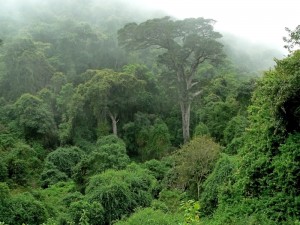 To my mind, this means that compiling old and discovering new efficiencies in those areas of potential overlap between environmental and human health is looking increasingly like a very sensible strategy. In other words, there are still huge opportunities and a pressing need to identify and leverage health gains to help stem environmental losses. And vice versa.
To my mind, this means that compiling old and discovering new efficiencies in those areas of potential overlap between environmental and human health is looking increasingly like a very sensible strategy. In other words, there are still huge opportunities and a pressing need to identify and leverage health gains to help stem environmental losses. And vice versa.
In fact, from global targets on climate change mitigation and biodiversity conservation to disaster risk reduction and sustainable development, identifying potential and demonstrating genuine health ‘co-benefits’ is a growth industry. This approach is increasingly being used to find, and fund, mitigation and adaptation actions to address global environmental challenges.
The New Climate Institute, for example, estimates that more ambitious emissions reductions targets in the EU could prevent around 40,000 premature deaths per year from air pollution and create around 350,000 jobs in the domestic renewables sector.
Similarly, the UK’s Natural Capital Committee reports that investing in equitable access to green spaces would pay off with improved physical and mental health, generating savings of around £2.1 billion per year.
And perhaps a tad more abstractly, the Centre of Global Health Security highlights how successes in global environmental governance could be leveraged for better global health governance. This illustrates not only the potential breadth of co-beneficial links between environment and human health, but that not all of them necessarily require a natural capital accounting framework to take seriously (although this is clearly helping!).
So while the pursuit of win-win solutions for the environment and health in isolation is potentially an unhealthy obsession, when better to try than on World Environment Day? Working through the costs and trade-offs that typically follow can wait, at least until tomorrow.
Find out more on Grantham research on environmental change and health

by Roan du Feu, PhD student, Science and Solutions for a Changing Planet
The marine renewable energy sector is poised and ready, waiting to harness the power of tides and waves with underwater tidal turbines and floating wave energy converters. A shift to renewable energy sources is essential to reducing global carbon emissions, but what are the consequences of these new technologies? Are we prepared for the effects of filling our already fragile oceans with rows of large, moving structures? Will we cause irreparable damage? Or might there even be some positive effects?
These are all questions relevant to my thesis and so, for two weeks, I attended a course on Marine Renewables and the Environment held at SAMS (the Scottish Association of Marine Science). The aim of this course was to explain the interactions between the abundant and varied ecology of the seas and the devices that will inevitably be placed in the midst of them.
SAMS is one of the oldest oceanographic organisations in the world and one of Europe’s leading research centres for marine science. It takes a great interest in marine prosperity and sustainability, climate change and, crucially, renewable energy. SAMS is located next to Dunstaffnage castle on a wild and exposed spit of land just north of Oban, Scotland, where the sinuous Loch Etive breaches into the grand, island-studded Firth of Lorn.
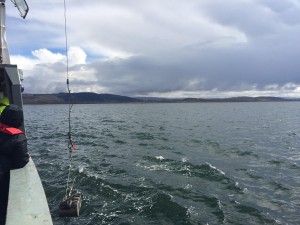
Over the course of two weeks we studied all forms of marine life. The flora ranged from the tiny, sometimes unicellular, phytoplankton and drifting algae, to the larger seaweeds. The fauna, a rather more extensive group, covered zooplankton, sponges, hydrozoa (including jellyfish and coral), segmented worms, molluscs, crustaceans, echinoderms (starfish and urchins, for example), bryzoans (moss animals), ascidians (sea squirts), fish, and of course the many marine mammals and seabirds that live and feed in the marine environment.
Something that struck me was the vast disparity, between the variety of marine flora and fauna. The dependence of plants on light to photosynthesise is at least partially responsible. The turbidity of British seas means that larger plants can only survive to a depth of about 25m, and even phytoplankton only descend to about 50m. Marine fauna on the other hand have no such limit, and can thrive many kilometres below the surface.
Marine renewable devices can have both negative and positive impacts on these many types of life. But what was made very clear was the great uncertainty in the extent and degree of almost all of these effects.
The most commonly discussed consequence of tidal turbines is blade strike. This represents a potential issue for marine mammals, large fish / sharks, and various types of diving bird, many of which dive well below the depth at which you might expect to find a turbine (guillemots, for example, have demonstrated the almost unbelievable ability to dive up to 180m below the surface in their search for fish). The extent of this problem is completely unknown, it is possible that such animals will be adept at avoiding turbine blades, but it is possible they will not.
T hen there is the noise produced during both the construction and the operation of such devices. This could potentially scare off or disorientate some marine mammals (or during pile driving even deafen them) while possibly attracting other more curious species. In this case mitigation techniques such as using bubble shields to damped sound during construction could the limit negative effects.
hen there is the noise produced during both the construction and the operation of such devices. This could potentially scare off or disorientate some marine mammals (or during pile driving even deafen them) while possibly attracting other more curious species. In this case mitigation techniques such as using bubble shields to damped sound during construction could the limit negative effects.
Another interaction that was heavily discussed was that of the artificial reef effect. Whatever the marine renewable device in question, one immediate change to the local environment will be the addition of large, sometimes complex, structures which provide a new, different habitat type upon which life can and will grow, often significantly increasing the biomass of the area.
This is not necessarily a good thing as structures in the water have been known to provide stepping stones for invasive species that are otherwise unable to cross wide channels. This influx of both floral and faunal growth will attract fish which in turn will attract marine mammals and seabirds into a, potentially, dangerous area. In fact, considering that fish also like to hide in the shelter given by these structures, and that such areas will likely become no fishing zones it seems probable that a marine renewable development could become a veritable haven for fish. Whether the knock-on effects of this, on other marine life or indeed on fishermen, are positive or negative is unknown.
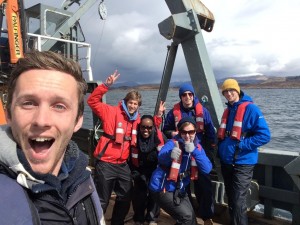
The main thing I am now aware of is the high levels of uncertainty in expert opinion. I had assumed that putting devices in the sea would be an inherently bad thing for the local environment (although good for the world at large), but is it? Possibly, sometimes, but we don’t yet know. Then I was told of all the life that would actually be drawn to such devices, surely that’s good? Possibly, sometimes, but we don’t yet know.
The introduction of marine renewables to the seas is inevitable. It is one of many things that has to happen if we hope to combat the inescapable advance of man-made climate change. But I have learned that it has to be done with care, it has to be monitored well, and the information gathered has to be put to use. It seems possible that such technology could be implemented without contributing to the decline of the oceans, but only as long as it is done in an appropriate and measured manner. For what is the point in trying to save the planet if we end up destroying it in the process?
Read more about Roan’s PhD project
This blog post is part of a series on Responding to Environmental Change event, organised by the Natural Environment Research Council (NERC) funded Doctoral Training Partnerships at Imperial (SSCP), and the University of Reading and the University of Surrey (SCENARIO).
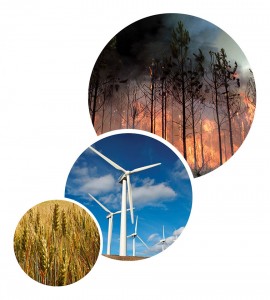
A recent event in London brought together emerging environmental scientists (PhD students and early career researchers) with leaders from business, policy and academia to explore the challenges posed by environmental change and opportunities to work in collaboration to respond to these.
Communities today find themselves and the environments they live in under increasing pressure. This is driven by growing populations, urban expansion and improving living standards that place increasing stress on natural resources. Added to this is the rising threat from environmental hazards and environmental change.
Research, development and innovation within the environmental sciences and beyond offers the opportunity to manage these pressures and risks, exploring how we can live sustainably with environmental change, whatever its drivers.
Discussion at the event covered three key societal challenges and their implications for business and policy. A summary of these talks has been captured by students attending the event and can be found below.
The event was organised by the Natural Environment Research Council (NERC) funded Doctoral Training Partnerships at Imperial (SSCP), and the University of Reading and the University of Surrey (SCENARIO).
Natural resources are fundamental for wellbeing, economic growth and sustaining life. Greater demand for food, water and energy requires better management and use to reduce stress on natural systems and ensure a sustainable future.
Read more in a report by Jonathan Bosch, a first year SSCP PhD student researching transitions to low-carbon energy systems.
Environmental hazards are becoming more frequent and severe, with potentially serious impacts on people, supply chains and infrastructure globally. Advancing our knowledge and understanding of these hazards, and the processes involved, will allow us to better predict, plan for and manage the risks in order to increase resilience to these changes.
Read more in the report by Malcom Graham, a first year SSCP PhD student researching saline intrusion in coastal aquifers.
In addition to natural variability, human activities are causing rapid, large-scale climate and environmental change. Understanding how these processes work as a whole Earth system can improve our understanding of the impacts of these changes and inform responsible management of the environment.
Read more in a report by Rebecca Emerton, a first year SCENARIO PhD student researching approaches to global forecasting of flood risk.
Matthew Bell, Chief Executive at the Committee on Climate Change, concluded the event with a talk on the road to Paris and the issues that could be faced in the climate negotiations.
Read more in a report by Samantha Buzzard, a third year NERC PhD student at Reading investigating the role of surface melt in the retreat and disintegration of Antarctic ice shelves.
Watch videos of all the talks on our YouTube channel.
Find out more about the Science and Solutions for a Changing Planet DTP at Imperial College London.
Find out more about the SCENARIO DTP at the University of Reading and University of Surrey.
This blog post by Jonathan Bosch, an SSCP DTP student, is part of a series on Responding to Environmental Change, an event organised by the Natural Environment Research Council (NERC) funded Doctoral Training Partnerships at Imperial (SSCP), and the University of Reading and the University of Surrey (SCENARIO).
See the full list of blogs in this series here.

Natural resources are fundamental to human well-being, economic growth, and other areas of human development. Greater demand for food, water and energy resources against the current backdrop of climate change and population growth requires better management and more efficient use of natural resources to reduce the resulting stress on the earth’s natural systems.
In this “benefiting from natural resources” section of the programme there were three talks from representatives of three distinct sectors, presenting how the respective areas of industry, regulatory bodies, and academia are currently dealing with the management of natural resources.
Andy Wales, Director of Sustainable Development at SABMiller plc, made an arresting case for why sustainability is not only important for their business model, but also why it’s vital for its continued success. SABMiller is a multinational beer and soft drinks producing company.
SABMiller presents itself as a local beer brand, although it operates in 40 countries. As such, the business is exposed to the perturbations and vulnerabilities of, principally, local water supplies, but also grain and packaging supply chains. And with 80% of its income coming from developing markets, it cannot secure its future profitability without smart resource management. Procuring primary products from local markets is important to achieving this and therefore water management is critical.
The ‘Prosper’ programme, sits on five sustainable development pillars, and has as its catchphrase, “When business does well, so do local communities, economies and the environment around us. When they prosper, we do.” The five pillars are associated with a “thriving, sociable, resilient, clean and productive world.” Encompassed in these areas is an acknowledgement that not only do water supplies matter, but, for example, ‘clean’ – reducing its carbon footprint, and ‘productive’ – food and land security, are central to ensuring a profitable future.
A number of case studies went some way in demonstrating the achievements of Prosper to date. Already, $40m in efficiency savings have been achieved by programmes implemented in Colombia and India, using a systems approach which helped farmers choose better crop types – reducing water consumption by 30% and raising crop yield by 20%.
In Bogota, India, Prosper highlighted issues of poor land management which caused regular and intolerable spikes in water prices. Water run off was high and productive yield of food crops and milk production was low. A sophisticated approach tackled the problem by simply changing the breed of local milk cows to better benefit from the local ecological conditions. The result was an increase in the milk yield of the region and a sharp reduction in water run-off, securing milk and water availability for all users.
Prosper continues to forge collaborations worldwide in the nexus of water, food and energy security. A partnership with the WWF will continue development in that direction.
Miranda Kavanagh, Executive Director, Evidence Directorate of the Environment Agency, focused her talk on ‘Fracking’, or hydraulic fracturing, which is one of the unconventional techniques of oil and gas extraction currently attracting world-wide media attention for its, as yet, undetermined environmental risks.
The Environment Agency’s role is in delivering on a policy framework set by the relevant government agencies, principally DEFRA. It has three specific roles in achieving this objective: Regulating industries and activities that can potentially harm the environment; advising government, industry and the public about more sustainable approaches to the environment; and specific operational work to protect and improve the environment.
The Environment Agency (EA) is guided by its Evidence Directive, which aims to use evidence to “guide and inspire” their actions and those they advise. It states that they must use the best available evidence, use environmental data to support the decisions of others, and develop a joined up approach to evidence, among other equally impressive visions.
On Fracking, the EA must balance, pragmatically, the needs and interests of different groups concerned with environment, resource exploitation and people, as Kavanagh clarified in the Q&A session. As well as the pure environmental impacts, the EA must consider the effects on people and communities, but also the need for fuel exploitation and energy security; areas of interest of both government and the energy sector.
These needs were highlighted in the Potential Contribution report produced by the UK Institute of Directors, which highlighted the social benefits of one scenario to include a likely decrease in the use of imported gas, 70,000 energy jobs and a net benefit to the Treasury.
These benefits are offset by the environmental risks, which are complex, and in some cases, undetermined. The known risks involve a range of air, land and water pollution, the release of chemical and radioactive substances, and a range of spatial and time dependent risks, which will affect exploited regions differently, and on differing timescales. For example, ground water contamination may take decades to become detectable.
The EA works in many areas to produce evidence for the advice and regulation of future potential fracking operations. The EA was, for example, instrumental in producing a UK geological map of the subsurface extent of shales and their vertical separation to aquifers. These were important as a preliminary risk assessment for a broad geological understanding of the importance and distribution of our groundwater resource. This type of evidence gathering must be done for the range of environmental concerns listed above.
Also highlighted were collaborations and opportunities which the EA are eager to develop. NERC Fellowships and various PhD Studentships are ongoing and include projects as broad as evaluating methodologies for environmental risks, but also the invention and patenting of new instruments for air-quality impacts and other applications.
The EA welcomes partnerships, particularly those involved with their Collaborative Research Priorities. Their expertise and extensive datasets are important resources which other organisations with similar resources and objectives may make use of to aid progress on some key questions within applied environmental science.
Elizabeth Robinson, Professor of Environmental Economics at the University of Reading presented two projects demonstrating her work on how scientists and social scientists can and have been working together to improve our ability to benefit from natural resources.
There has been, in the past, little need to actively manage our natural resource base, but the pressures of climate variability and population growth have made optimising the use of these resources effectively much more important. The relationship between ecosystem services – measurable by ecological scientists – and agricultural intensity – understood by management and social structures – becomes a crucial collaboration.
But what is the relationship between these inextricably connected issues? Robinson was concerned, as a trained economist, with ‘drawing a curve’ between these two dimensions, which would describe how and why a change in the intensity of agriculture would affect the ecosystem services which are critical to the sustainability and well-being of communities.
In Ghana, cocoa production was investigated in order to understand how some farmers may choose to intensify their agriculture and why some do not, and furthermore some intensifications were damaging the ecosystem more than others. Ecologists were employed to determine the relationship between intensity and ecosystem services, while social scientists interviewed farming communities to discover how the forest land was managed and what were the limiting factors to best managing the land in benefiting farmer yield and ecosystems.
It was found that there are often complicated social factors affecting how the farms and forest land was managed, and these included the ability of farmers to use or afford fertiliser, shift cultivation to newly converted forest when soils are exhausted, and even whether farmers benefit from pollination by nearby forests. It was seen that many local perceptions of resource space and property rights restricted the farmers’ ability to optimise their practices even if they desired to do so. Among many other constraints, poverty, labour availability and wages, and institutional contexts affect the outcomes when farmers attempted to intensify their practices.
Ultimately, a simple behavioural model can attempt to capture the ecological boundaries, and social constraints, and can be used to propose routes toward an optimum solution for ecosystem services and farmer preferences and resources.
The second case study was related to managing fisheries in Tanzania, where such efforts are typically addressed only when falling stocks become an issue. This project also highlighted the need to observe the socio-economic situation and implement credible solutions which may indeed lead to a slower recovery of the ecology, but which resolve societal tensions and allow the fishing communities a reliable income without implementing a total fishing ban. A ‘Bio-economic’ model was indispensable in this project too.
Watch a video of the talk on our YouTube channel.
This blog post by Malcom Graham, an SSCP DTP student, is part of a series on Responding to Environmental Change, an event organised by the Natural Environment Research Council (NERC) funded Doctoral Training Partnerships at Imperial (SSCP), and the University of Reading and the University of Surrey (SCENARIO).
See the full list of blogs in this series here.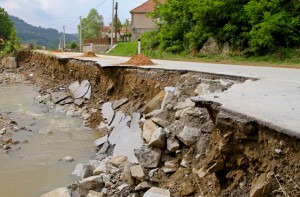
Environmental hazards are becoming more frequent and severe, with potentially serious impacts on people, supply chains and infrastructure globally. Advancing our knowledge and understanding of these hazards, and the processes involved, will allow us to better predict, plan for and manage the risks in order to increase resilience to these changes.
This session focussed offered perspectives from academia (Imperial College London), the world of (re)insurance (Willis Re) and the charity sector (Oxfam).
David Simmons, the Head of Strategic Capital and Result Management at Willis Re, began proceedings and impressed us by speaking with no slides or notes, describing it as a ‘liberating’ experience. Despite (or perhaps helped by) the absence of visual aids, his delivery was nevertheless engaging and humorous.
His talk focussed on the world of reinsurance, which he assured us was the ‘sexy’ part of the insurance sector, specialising as it does in catastrophe risk. He contrasted this with the banal nature of regular insurance work and the social death that ensues for most practitioners.
We were told that reinsurance, which covers the insurance companies themselves against major disasters, is suffering from too much capital. Stoically, David explained the reasons behind this: essentially, due to financial uncertainty in other sectors, no one else could offer the low risk and high returns on investment now commonplace in the reinsurance industry. This he attributed to a much greater understanding of catastrophe risk over the last few years than had previously existed.
Following on from Don Friedman’s modelling of hurricanes in the 1980s, which provided a basis for hazard and probability analysis, David explained how there has since been massive investment in producing ever more reliable models to understand these elements. Indeed, the process of developing models in itself seems to have driven the understanding of various components and allowed constraints to be placed on the ‘unknown unknowns’, a Rumsfeldism which seems to make its way into most talks on modelling these days.
The price of reinsurance has apparently dropped substantially in recent times, driven by the unprecedented levels of investment. In particular, we were told that reinsurance for many parts of the developing world comes at negligible cost, due in part to a reduction in the number of deaths from droughts as a result of more reliable aid. Although this is clearly a positive development, David was keen to point out that the arrival of aid was often too slow to prevent significant human suffering and damage to assets and infrastructure. The focus has therefore turned to more timely interventions and having better systems in place for disaster response.
We learnt that insurers are now playing an important role in driving best practice from governments, with many African countries having to present draft disaster response plans, audited reports on actual responses implemented by the government and the results of anti-corruption tests before they can join insurance programs.
David’s talk closed with commentary on the growth of various large-scale insurance schemes, many of them covering multiple countries. He cited the example of the African Risk Capacity, which is expanding from 5 to 10 members, and a scheme in the Caribbean which is now expanding into Latin America. He did highlight some pitfalls with the more inclusive approach to insurance, contrasting the approach to flood insurance in the UK, where higher risk properties pay an additional premium, with the French system where all households pay the same, thereby removing some of the incentive for individuals to reduce their risk.
Our second talk of the session came from Martin Rokitzki, former resilience advisor for climate change adaption at Oxfam. Humbly professing to be ‘the least scientific person in the room’, he could nevertheless point to 15 years of practical experience working on climate change and environmental issues.
His talk began by looking at what is actually meant by the term ‘resilience’, which appears to have numerous definitions relating to one’s ability to cope, adapt, prepare or thrive when faced with shocks, stresses or uncertainties.
When presented with such an uncertain framework, we were unsurprised to learn that there is no ‘cookie-cutter or cook-book’ for resilience and that the term may be applied to a huge range of social and economic groups. By talking about his experiences with Oxfam, Martin was at least able to narrow his focus to addressing the resilience of the world’s poor.
Even within this constraint, understanding hazards and impacts was presented as a multi-faceted exercise. Variations in the spatial extent of damage, its intensity, duration, rate of onset and level of predictability could all have profound effects on the planning process. Counterintuitively, Martin felt that slow-onset hazards were often the hardest to address and his talk focussed on how to deal with challenges of that nature, such as the East African food crisis, glacier melt in Nepal and salt intrusion in Tuvalu.
We were told that Oxfam’s approach to resilience involves 5 key areas: livelihood viability (i.e. the economic buffer to disaster); innovation potential; contingency resources and support access (i.e. provision of aid); integrity of the natural and built environment (in the case of the extreme poor, they are directly dependent on the surrounding natural environment); and social and institutional capacity (i.e. governance).
In contrast to the preceding speaker, Martin’s presentation abounded with eye-catching schematics, highlighting various approaches to disaster management. Key to these were the integration of policy and projects to get a successful outcome. To illustrate this, he presented us with the ‘Cycle of Drought Management’ which moves through stages of preparedness, disaster response and relief, reconstruction and mitigation. Alas, the paucity of data in 80-90% of affected areas means that the preparedness stage is often a huge challenge. Our presenter highlighted this as a key reason for Oxfam to collaborate more closely with scientists.
Towards the end of his talk, Martin touched on Oxfam’s R4 approach to risk, encompassing risk reduction (managing resources well), risk transfer (insurance), risk taking (credit for investment) and risk reserves (savings). Without this sort of strategy, seasonal food shortages could easily become year round famines. As part of this Oxfam has been helping to administer financial services in remote rural areas and developing a focus on flexible and forward-looking decision making.
Martin’s final message was that we need more collaboration between the ‘thinkers’ and the ‘doers’ – a clear call for the science community to engage more directly and more frequently with aid agencies and other environmental organisations.
Our final speaker of the session was Imperial’s very own Professor Ralf Toumi, who described his ongoing work on the OASIS project, an open access model for looking at the impacts of extreme weather events on the built environment.
His main driver for the project was the limited number of companies providing assessments of risk in this area, thereby giving a fairly narrow field of views on risk to the insurance sector. He reflected that this has not been helped by a continuing barrier of information between researchers and insurers and the ‘black box’ approach to disaster modelling which exists within the commercial world.
Following the previous speaker’s flurry of eye-catching diagrams, Ralf was not shy to present a few schematics of his own, illustrating the concepts behind OASIS. These highlighted the user’s ability to select combinations of models to give a tailor-made view of risk, including a broader spread of results and a greater understanding of model bias and uncertainty. To highlight the point, Ralf asserted that vulnerability modelling (i.e. the damage caused by an event) has a much greater level of uncertainty than hazard modelling. Indeed, one of the key challenges of the OASIS project has apparently been to get hold of datasets on damage, information which some players in the industry have been reluctant to provide.
A further challenge, we were told, is the effect of giving insurers greater experience in using this modelling framework: the desire for greater complexity. Whilst models appear to be ever more powerful (a 30 year dataset can apparently now be used to predict a 1 in 1000 year event!) there is a serious challenge to translate this complexity from the academic / journal environment to insurance professionals. There has also been a need to standardise the wide array of different data formats associated with OASIS’ component models.
Despite these challenges, it appears that OASIS is flourishing. Our presenter proudly displayed a series of media articles after their press release went viral, along with a list of 44 members of the OASIS Loss Modelling Framework, a list that includes numerous insurance and reinsurance companies. Their many associate members include a variety of government bodies, academic institutions and IT companies.
A combined question and answer session followed on the three presentations. It began with the question of how all these ‘big complex’ models have been validated with data. Professor Toumi agreed that validation is a huge issue, although hazard validation is much easier to do, using historical datasets, than validating predictions of damage, which sometimes diverge wildly. David Simmons was able to point to a recent paper he had written on model validation and highlighted that the non-stationary world we live in means that there are never sufficient data. Nevertheless, he believed that even non-validated models are better than nothing and that the modelling process aids understanding as much as the end result. He also highlighted that satellite datasets can act as a useful first-pass method for validating models.
The second question focussed on how we transition from looking at short-term resilience to combatting longer-term changes. Martin Rokitzki responded that although we live in a short-term world, transformative scenario planning is more commonly done nowadays, which is often based on narratives rather than data alone. Adaptive management is also more common.
Another audience member (currently working for one of the London mayoral candidates) wondered what question we should pose to mayoral candidates of large cities in relation to risk management and resilience. The panel were somewhat stumped by this, but (ironically) opted to answer the question about a question with another question: Martin Rokitzki wondered who has responsibility for risk management. Should adaptation be a government service, should it be borne by individuals or even by the private sector? David Simmons cited an example of the World Bank trying to cover industrial areas against earthquakes and reward good design through financial incentives. Unfortunately, the scheme struggled through a lack of political will to take decisions which might be unpopular with their electorates, despite having clear long-term benefits.
The final question related to the possible impacts of a catastrophic asteroid impact and the huge disparity between the insurance fund set aside to cover Florida’s coastline from storm damage and flooding ($2 trillion) compared to a much smaller sum assigned globally for larger-scale catastrophes like asteroid impacts ($0.5 trillion). David Simmons responded that the insurance industry focuses on the short-term, partly due to the 5 year tenure of most CEOs. This makes asteroid impacts beyond the timescale of concern. Another contributor to the disparity is that flood insurance is governed by a regulator in Florida. Despite this, David felt that Florida now has enough reinsurance capacity and that there is now a need to better understand hazards like asteroids.
And as we all dwelt on what sort of cosmic destruction may be in store, the session was brought to a close, leaving us with the much simpler conundrum of what to have for our lunch.
Watch a video of the talk on our YouTube channel.
This blog post by Rebecca Emerton, a Scenario DTP student at University of Reading, is part of a series on Responding to Environmental Change, an event organised by the Natural Environment Research Council (NERC) funded Doctoral Training Partnerships at Imperial (SSCP), and the University of Reading and the University of Surrey (SCENARIO).
See the full list of blogs in this series here.

In addition to natural variability, human activities are causing rapid, large-scale climate and environmental change. Understanding how these processes work as a whole Earth system can improve our understanding of the impacts of these changes and inform responsible management. One key challenge is how we monitor and record environmental data, and the role this data can play in managing the environment.
The third challenge area of the Responding to Environmental Change event explored the management of environmental change, including how environmental data is monitored and recorded, and challenges faced in utilising this data.
Jacquie Conway, Head of Institutional Relations UK within Airbus Defence and Space – Geo-Intelligence, opened the afternoon with a discussion of the practical applications of Earth Observation (EO) data. A key question was presented: “Why Space?”, highlighting the benefits of EO for providing evidence used to assess how much land change is occurring, where this land change is taking place and the causes and impacts of the change, alongside uses in model validation and determining possible future changes. Examples were given such as forest mapping and monitoring, in order to identify degradation and illegal logging, and the changes in these over time. Further examples include food security and crop sustainability – analysis of drought areas and possibilities for improved farming management practices, and urban planning through monitoring land use change and developing cities. Disaster management is also key, with EO data and mapping used in emergency response, recovery and preparation.
The challenges associated with EO and Big Data are continuously evolving, with increased volume, diversity and value of EO data, in conjunction with non-space data. Aspects such as quality, continuity, timeliness and uniqueness of data are significant in approaching the Big Data challenge. Emerging solutions include the Airbus Processing Cloud, which provides a platform for hosted processing, with examples given of completed successful processing and reprocessing campaigns. Where the previous data processing time for one mission was greater than 700 days, it is now possible to process this data in just 2 weeks through use of the Airbus Processing Cloud. Alongside data processing, the platform will enable development of new products and services through a partnership approach, with the intent to support SMEs, research organisations and Universities, among others.
Copernicus was introduced as the European Flagship Earth Observation Programme to monitor environmental change, by Jacquie Conway, and discussed further by Dr Farhana Amin (Defra). Copernicus is led by the EU and co-ordinated by the ESA, and is the European response to a global need to manage the environment, providing necessary data for operational monitoring of the environment, and for civil security. With a €3.8bn investment in Copernicus, 6 missions (each with 2 satellites) will be launched, resulting in up to 8TB of new, open access data on the environment, per day. These missions will provide valuable information for land, marine and atmosphere monitoring, alongside emergency management, security and climate change services.
Dr Amin gave a policy perspective on managing environmental change, highlighting the responsibilities of Defra for policy and regulation on environment, food and rural affairs, including the protection from floods and plant/animal diseases, alongside improving the environment and rural services. The statutory obligations of Defra range from monitoring pesticide residues on food, to managing natural resources through monitoring of air quality and biodiversity. Emphasis was placed on Evidence-Based Policy, using observations, knowledge and scientific research to provide the basis for all policies. Examples were given of current programmes such as Cefas – the Clean Seas Environment Monitoring Programme, which aims to detect long-term trends in the quality of the marine environment through collection of high quality, standardized data. Other examples include the monitoring of bathing water quality, and UK Surveillance Schemes involving partnerships between the Joint Nature Conservation Committee (JNCC), NGOs, research bodies and volunteers to monitor wintering and breeding birds, butterflies, bats, plants and other mammals.
Satellite applications also have a long history of use within Defra, for research and monitoring of land use, roads and marine environments, and GPS data for forestry monitoring, flood monitoring and field sample collections. Again, challenges with EO were discussed, such as the highly complex processes involved, the need for high quality data and regular analysis, working around multiple partners and methodologies, and the resource intensive nature of environmental monitoring.
Professor Anne Verhoef (University of Reading) provided a research perspective on managing environmental change, discussing steps towards an improved understanding and sustainable management of the ‘Critical Zone’ (CZ), which extends from groundwater reservoirs to soil, to the surface and lower atmosphere – in other words, the zone in which we live. The CZ affects food, water and energy resources, and plays a major role in our weather and (micro)climate, also allowing us to mitigate the effects of extreme events and environmental change. Advances in monitoring of the CZ at many time and space scales (for improved understanding and management), include novel monitoring of field-scale soil moisture and a wireless underground sensor network. Also on the theme of Earth Observation, imaging such as X-Ray CT imaging and remote sensing play a role in understanding and managing the CZ.
Another key aspect is modelling of the CZ, using various models to study part of, or the entire, CZ, such as land surface models (within global circulation models, e.g. JULES), groundwater models, and Soil-Vegetation-Atmosphere-Transfer (SVAT) models. SVAT models can further be coupled with remote sensing (EO) data of multiple types and at a range of spatio-temporal scales, leading to more generic tools for environmental research and management. Versatile tools exist allowing the calculation of crop yield, photosynthesis etc., such as the SCOPE model, which is an SVAT model supporting the direct interpretation of EO data. It was concluded that improving models to include more realism, and combining them with EO and remote sensing products, alongside the use of novel in-situ monitoring techniques (for improved ground data), will improve our understanding of the CZ and help move towards sustainable management of environmental change.
Both the similarities and differences between the perspectives from business, policy and research, and the challenges faced in using EO data for the management of environmental change, show the benefits of collaboration and partnerships, alongside the advances and extensive work towards sustainable management of the changing environment.
Watch a video of the talk on our YouTube channel.
 The Climate and Environment at Imperial blog has moved. View this post on our new blog
The Climate and Environment at Imperial blog has moved. View this post on our new blog
by Dr Karl Smith, Department of Civil and Environmental Engineering
Every waking hour, I ingest water. Not always in its purest form, but near enough. Energy is important and right now (and rightly so), carbon is capturing headlines. But water is fundamental to our livelihoods.
The UN has designated 22 March World Water Day: “a day to celebrate water”. And why not? Never mind that it’s essential to all life forms. For modern living, it’s a necessity: we need 10 litres of water to make one sheet of paper; 182 litres to make a kilo of plastic. We’re not about to run out of seawater, but what about drinkable freshwater? A glance at the UN’s water statistics reveals the urgency of our situation.
In developing countries, 90% of wastewater flows untreated into water bodies. An estimated 1.8 billion people worldwide drink water contaminated with faeces. By 2030, 47% of the world’s population will be living in areas of high water stress.
In 60% of European cities (population > 100,000 people), groundwater is being used faster than it can be replenished. As the primary source of drinking water worldwide, groundwater is vitally important. In fact, groundwater comprises 97% of all global freshwater potentially available for human use (the UN don’t qualify this definition, but one can probably assume that 97% of all drinking water is groundwater – further enlightenment on this is welcome). Moreover, our use of groundwater is increasing by 1-2% per year.
If we look west to the US then we reach California – a drought stricken state with, according to senior water cycle scientist Jay Famiglietti of the NASA Jet Propulsion Laboratory, only one year of water left in its reservoirs and rapidly disappearing groundwater.
Dwindling water resources are a global challenge. However, at present (again, this is UN data), 54% of the world’s population live in cities. By 2050, this figure will approach 70%, with 93% of urbanisation occurring in developing countries. If you reduce the problem to securing clean water for city dwellers, then it becomes markedly more manageable – at least, if you have big budgets.
London is currently tussling with the proposed Thames Tideway Tunnel (TTT), a £4.2 billion (at 2011 prices) “super sewer” designed to contain overflows of sewage, currently in the order of tens of millions of tonnes a year, and hence prevent the pollution of the river Thames.
Although it will help future-proof the capital against climate change, the TTT won’t do much else than divert sewer overflows: a big spend for one single solution. Moreover, its carbon footprint is not small. A shortcoming of some climate change adaptation interventions is that, through their production and often, operation, they may only amplify the root of the problem.

If we want value for money, then why not demand more than just one benefit? One stone, but at the very least, two birds.
Consider combined heat and power (CHP) plants, which generate two energy types, at improved efficiencies of conversion, from a single fuel. Do we therefore need one pipe network for drinking water, one for waste water and one for stormwater? Plus an array of energy intensive pumps?
Urban floods are invariably caused by runoff from impermeable surfaces – roofs, roads and pavements. A carpet of urban greenery can both trap and, via the plant root network and soil media, decontaminate runoff, removing the need for a centralised stormwater system. The grey city can grow green.
For cities to be self-sufficient and resource-smart, we can’t let stormwater dissipate into drains. Drinking harvested rainwater is problematic, but irrigation of city greenery – not only garden plants but also, fruit and vegetable crops – is not.
Plants are truly multi-functional. Their benefits include enhancements to human health and well-being, as well as mitigating the urban heat island effect and promoting biodiversity. This is the Blue Green Dream paradigm: the smart use of plants, in concert with the local environment and manmade systems such as storage tanks, to sustainably manage water resources and also, deliver myriad urban benefits.
The Blue Green Dream – a multi partner, Climate KIC funded, Imperial College led project – is harnessing ecosystem systems to achieve climate change resilience. For further information, see the project website or contact the project manager, Dr Karl M. Smith.
by Bhopal Pandeya, Research Associate (ESPA Fellowship), Grantham Institute
Mountains are often referred to as ‘water towers’ as they provide fresh water to people and biodiversity. The Himalayan region is one of the few hot spots where several big rivers originate and supply water to hundreds of millions of people across the mountains and further downstream. However, higher up in the mountains especially in trans-Himalayan region, there is very little accessible water for local communities. The region receives very low rainfall and thus water supply is largely dependent on the timely occurrence of snow fall and ice melts in the upper mountains. The Upper Kaligandaki Basin (located in Nepal) is one such area where water scarcity is very high. Upland communities are constantly facing serious water shortage which particularly affects their agricultural land.
In Upper Kaligandaki Basin, croplands are located along the river valleys which act as oases in the Himalayas. Traditionally, local people practice an intensive cropping system, growing different crops and vegetables to sustain their lives, and agricultural remains the main source of local livelihoods. But, local people are experiencing increasing difficulty with farming largely due to the unpredictable nature of water supply in local streams. They are now concerned by the changing pattern of snow fall in upper mountain areas and its impact on water flow in the lower regions. People are trying to cope with this situation by adopting various measures such as introducing more resilient crops like apple and walnut, using water harvesting systems and equitably sharing available water. This demonstrates local people’s extraordinary adaptive skills in managing their resources sustainably. To some extent, these measures are helpful in coping with these uncertainties.
Recent developments in the region, especially the construction of roads and the expansion of human settlements, are proving unsustainable and are making already scarce agricultural lands even more vulnerable. These activities lack proper consideration of how to maintain key ecosystem services provided by water and soil resources. Agricultural land and traditional water supply systems are particularly threatened by constant encroachment and land degradation (erosion and landslides) resulting from these activities. As a result, local communities’ main sources of livelihoods are in great danger. At the same time, the whole region is passing through a socio-cultural and demographic transformation which is also challenging especially considering the lack of enthusiasm of younger generations for farming.
In this situation, an innovative approach can build a better understanding of these major ecosystem services and integrate them into local policy and decision making. As one elderly local firmly put it, “our farmlands are highly productive, no need to go abroad for earning… we can earn better here. We produce highly priced crops, fruits and vegetables. But, there are some big problems… water supply is becoming more disruptive, soil loss is extensive and there is also less and less participation of the younger generation in farming practices. We need to address these problems immediately, so we can improve the agricultural production and increase our household incomes”. Clearly there is a great need for a locally suited ecosystem services approach (guided by scientific, socio-political and economic understandings) to improve local livelihoods.
Find out more about the Mountain-EVO project
This post was originally published on the ESPA blog. View original post.
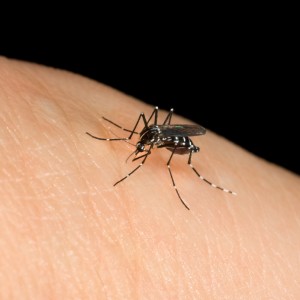
The Climate and Environment at Imperial blog has moved. View this post on our new blog
By Dr Paul Parham, Honorary Lecturer in Infectious Disease Epidemiology
Many tropical diseases such as malaria, Chagas disease and dengue are transmitted to humans via mosquitoes and other carriers known as vectors. These vector-borne diseases continue to have a major impact on human health in the developing world: each year, more than a billion people become infected and around a million people die. In addition, around one in six cases of illness and disability worldwide arise from these diseases.
Malaria arguably continues to attract the most attention of all the vector-borne diseases by virtue of causing the greatest global disease burden. However, others such as dengue are not only resurgent in some regions, but threaten a vast proportion of the world’s population.
Climate change remains a substantial threat to future human health and since the behaviour of disease carriers like mosquitoes is known to be extremely sensitive to temperature and rainfall, it seems unquestionable that climate change will affect many, if not all, of these diseases. What is less clear, however, is the extent to which climate increases the risk of becoming infected in certain regions compared to other factors such as poverty or fragile health systems.
In addition, although the number of new cases of diseases such as malaria appears to be declining worldwide, it is still increasing in many regions for a variety of reasons; the continued spread of insecticide resistance, changes in land use, and difficulties in maintaining political interest pose considerable challenges. Which of these factors will be most influential over the coming decades remains up for debate and one that was raised in a special edition of Philosophical Transactions B.
The latest research, however, is clear and consistent in many of its findings. Different diseases, transmitted by different vectors, respond in different ways to changing weather and climate patterns. Climate change is very likely to favour an increase in the number of dengue cases worldwide, while many important mosquito populations that are able to transmit devastating diseases are changing in their distribution.
The latest maps show that many areas of Europe (including the UK) could become increasingly hospitable for mosquitoes that transmit dengue over the coming decades (the map below shows a projected change in suitable habitat for the Aedes albopictus mosquito). Similarly, other mosquito range expansions are likely to occur in the US and eastern Asia. If dengue and/or chikungunya are imported into these regions, there will be a considerable increase in the worldwide number of vulnerable individuals.
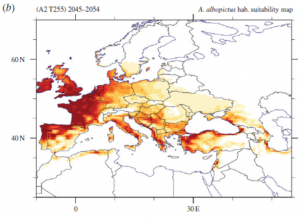
It is also clear that small changes in these so-called risk maps can have very large public health impacts. Tick-borne diseases (such as Lyme disease) are also predicted to expand in range as climate changes. Although, as before, plenty of other factors are likely to contribute, meaning that direct causation is very hard to attribute.
It is important to remember too that climate change is not just global warming; the latter refers to an increase in global mean temperatures, but there is also an overwhelming body of evidence demonstrating that rainfall is at least as important for many vector-borne diseases. Rainfall episodes have also been shown to provide a very good early-warning sign a few months in advance for outbreaks of West Nile Virus.
New research on African anti-malaria mosquito control programmes that involve spraying houses (to kill indoor mosquitoes) and distributing bed nets also shows that both temperature and rainfall can influence the degree to which programmes decrease new infections and, crucially, their cost-effectiveness. However, whether or not this is substantial enough to affect regional policy decisions about scaling up mosquito control programmes depends on factors such as how rapidly insecticide resistance emerges, the human immune response to malaria, and country-specific conditions.
In terms of malaria elimination in Africa, adopting the same approach in all affected regions is unlikely to be the best way forward. However, there is some new evidence to suggest that if efforts continue to be concentrated on scaling-up current intervention programmes in regions close to elimination, the longer-term effects of climate change will become far less important. Indeed, one of the most effective ways of protecting human health against climate change in the long-term is to further strengthen current disease control efforts.
As with the formulation of public health policies to deal with diseases such as Ebola, flu, and HIV, mathematical models are valuable tools that are widely used to make predictions about how different carrier-borne diseases are likely to respond to climatic changes. How reliable these predictions are is an important question and, like many areas of science, include unavoidable uncertainties. For example, people may change their behaviour and actions as climate change evolves – for example by migrating to other areas – which evidently makes forecasting more difficult.
New evidence has also shown that disease vectors may evolve in under a decade to changes in temperature, which conflicts with many current models that assume climate change only affects their ecology, not their evolution. Predictions that might be affected by climate change must therefore not only take account of these uncertainties, if they’re to be more reliable and useful, but also recognise that these predictions cannot strictly be disproved until the future arrives.
This remains a very active research field, but considerable progress in our understanding has been made over the last ten to 15 years. Better data on the links between vectors, diseases they carry and the environment is definitely required, as are better ways of quantifying disease risk for different populations and different diseases.

Many diseases have received very little attention so far on how climate change may affect future trends. One example is onchocerciasis (river blindness), for which tentative predictions suggest that we might expect substantial increases in the number of disease vectors in certain African regions over the coming decades.
Almost all models are currently based on single diseases, but many populations are unfortunately burdened with multiple diseases at any one time; understanding how climate change affects interactions between these diseases has attracted little attention to date.
One other important challenge for the field is the mismatch between the data current global climate models are able to provide and the information required by local public health officials to make more informed decisions; continued improvements in computing power are essential to progress. The predictions of our current models are not perfect and improvements in our understanding are certainly required.
To date, we have tended to react to disease outbreaks as they occur, but we need an increased focus on being more proactive; we cannot stop outbreaks of many of these diseases, but proactive risk management is less expensive (and more effective) than responding after a crisis. Ultimately, the challenge is not to address specific health risks due solely to climate change, but instead to ensure sustained progress is made towards decreasing the number of deaths and cases of these diseases for future generations.

This article was originally published on The Conversation.
Read the original article.
![]()